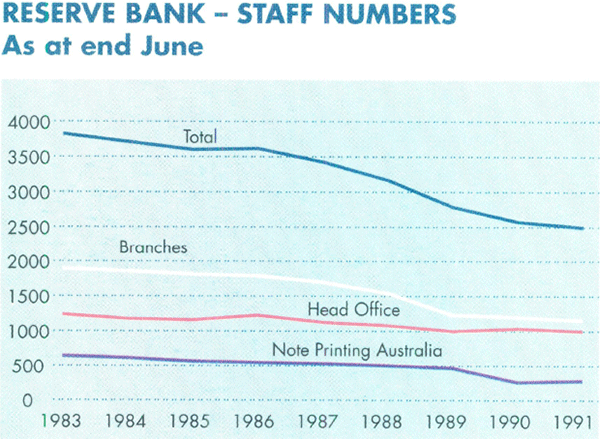Reserve Bank of Australia Annual Report – 1991 The Bank's Staff
Several important internal reforms were developed and progressively implemented in the Bank over the past year. The disruption inevitably associated with such changes has been managed without adverse effects on the performance of the Bank.
The extensive reforms currently in train are expected to yield substantial benefits for the Bank and its staff. They include major revisions to the organisation structure and salary classifications, as well as to appraisal, selection and appeal procedures. Their purpose is to raise the capacity of the Bank to respond effectively to demands on it and to enhance job satisfaction and career opportunities for staff. As with other parts of the finance sector, the effects of deregulation, competition, technological change and growing market complexity have presented important challenges for central bankers, and put a premium on organisational and personnel arrangements capable of both managing and anticipating change.
Revisions to the Bank's organisation structure and reporting lines were introduced in the early part of the year. These followed a careful assessment of current and prospective work-loads in the various areas of Head Office and in the branches. Four major functional groups were established – Economic, Financial Institutions, Financial Markets, and Services – each headed by an Assistant Governor. These positions were advertised within the Bank and externally; most Head of Department positions were similarly advertised. Assistant Governors and Heads of Department have had devolved to them increased responsibility for day-to-day management in their areas of operation, including budgeting, staff placement and training.
One part of this structural change was the creation of a new department, reporting to the Assistant Governor (Economic), to undertake longer-term policy-orientated research related to monetary policy. Another involved upgrading the capacity within the Financial Institutions Group for prudential supervision of banks in Australia.
An associated and complementary development has been the implementation of a new, flatter, eight-level structure of job classifications to replace the previous 23-level system which had become cumbersome and excessively hierarchical. The new arrangements put even greater emphasis on merit and performance: positions are advertised, selection processes are open and based on merit, salary increments in the broader bands are more widely available but are no longer automatic, being linked to performance in the job. Reporting lines have been shortened and new staff appraisal arrangements to be introduced in 1991/92 will form the basis for assessing performance for salary increment purposes. A system of special bonuses for outstanding performance is also to be implemented in 1991/92.

The changes made to selection and appeal procedures are geared to appointing the best people to vacant positions in an open and transparent way. The previous central control of staff selection has been replaced by the use of interview panels, chaired by a representative of the area where the vacant position is to be filled but also comprising representatives from other areas.
The process of filling jobs in the new structure is now nearing completion. Although staff savings were not the prime factor in the restructuring process, the new structure has approximately 200 fewer positions than previously. Voluntary redundancy arrangements were implemented to assist the exit of staff for whom worthwhile jobs no longer exist; all the indications are that those arrangements will fairly readily achieve the desired adjustment of staff numbers.
At 30 June 1991, the Bank had a total staff of 2,530 (including 320 at Note Printing Australia), about 50 fewer than a year earlier, and some 1,300 less than the peak in June 1983. Further falls are likely during the early part of 1991/92 as the voluntary redundancy offers are taken up. Senior staff who retired from the Bank included Dr M.R. Hill, Adviser, Mr W.E. Davies, Chief Officer, Financial Institutions, and several long-serving branch managers: Messrs N.T. Bevan, Marcus Diamond, A.P. Eviston, N.J. Mathews, and K.W. Stevens. Dr W.E. Norton resigned in May 1991 and took up an academic position.
Implementation of the new structure and the consequent streamlining of staff numbers have placed increased demands on staff. Many positions have taken on additional responsibilities. This is putting greater emphasis on upgrading the skills of existing staff through more comprehensive development and training programs and a range of work experience. While there was some disruption during the year as a result of restructuring, training courses were conducted at the Bank's training centre at Kirribilli, in the branches and in external training centres. Secondments were arranged with financial institutions in Australia and with other central banks. About 200 staff received study assistance from the Bank during the year, including four undertaking post-graduate study overseas.
Following an extensive review, and consistent with more broadly based legislative changes, revised superannuation arrangements for the Bank's staff came into operation in September 1990. These involve improved flexibility and some rearrangement of the structure of benefits, as well as incorporation of the 3 per cent superannuation productivity benefit.
The objectives and major strategies of the Bank's two-year EEO plan for the 1990 and 1991 period were issued to staff during the year; and detailed implementation of the program continues. The third annual report, required under the Equal Opportunity (Commonwealth Authorities) Act 1987, was tabled in the Commonwealth Parliament in November 1990.